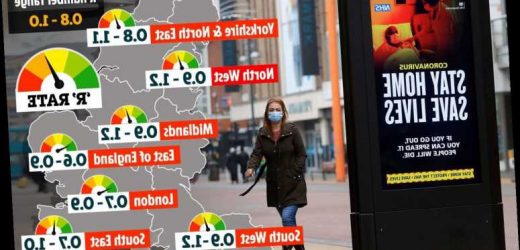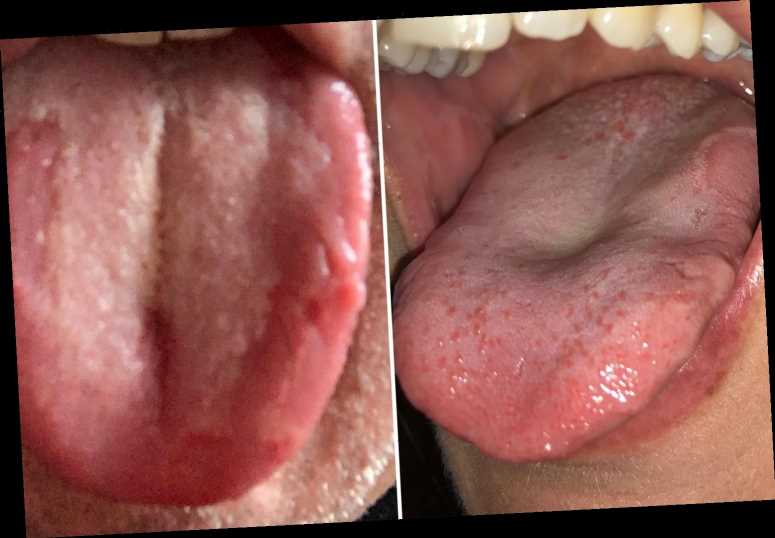BRITAIN'S official coronavirus R rate has fallen below 1 across the country – and could be as low as 0.6 in some areas, new estimates show.
The R rate – which represents the number of people an infected person will pass Covid onto – is now between 0.8 and 1, Sage today said.
? Read our coronavirus live blog for the latest news & updates
It was estimated to be between 1.2 and 1.3 nationally last week, when the growth rate also suggested the outbreak was continuing to get worse.
The Scientific Advisory Group for Emergencies today said the R rate is now below 1 in every English region with each falling compared to last week.
In the East of England the R rate may even be as low as 0.6, while for London and the South East it could be down to 0.7.
When the R rate is below 1, it means transmission is low and the epidemic is shrinking – but greater than that number suggests it's growing.
The last time the reproduction value was below 1 in the UK was December 11 and it peaked a fortnight ago when the range was between 1 and 1.4.
The values are shown as a range, which means the true R rate most likely lies somewhere between the upper and lower estimates.
It came as:
- Boris Johnson to address the nation tonight after record death rates were seen this week
- George Eustice said officials were looking at more ways to crackdown on borders and even shut them completely to stop new variants reaching Britain's shores
- Leaked documents revealed plans to give everyone who tests positive £500
- But the Treasury said they'd not even heard of the proposal and livid allies of the PM said it wasn't going to happen
- Plans are being firmed up for the UK to start forcing people to quarantine in hotels when they come into the country
'DANGEROUSLY CLOSE'
While the R number is heading in the right direction, experts warn that it remains dangerously close to the crucial 1 value.
A Department of Health spokesperson said: "Cases remain dangerously high and we must remain vigilant to keep this virus under control, to protect the NHS and save lives.
"It is essential that everyone continues to stay at home, whether they have had the vaccine or not.
"We all need to play our part, and if everyone continues to follow the rules, we can expect to drive down the R number across the country."
What does R rate mean?
R0, or R nought, refers to the average number of people that one infected person can expect to pass the coronavirus on to.
Scientists use it to predict how far and how fast a disease will spread – and the number can also inform policy decisions about how to contain an outbreak.
For example, if a virus has an R0 of three, it means that every sick person will pass the disease on to three other people if no containment measures are introduced.
It's also worth pointing out that the R0 is a measure of how infectious a disease is, but not how deadly
They also caution that there is a delay in the estimates as scientists use a range of data sources, which can take time to collate.
Sage also warns that as the pandemic is being managed at a local level, UK level estimates are "less meaningful" than previously.
The most recent data, published today, is based on data up to January 18 and represents transmission over the last few weeks.
Experts say all regions of England have seen drops in the R number and growth rate estimates compared to last week.
Sage said the R rate is estimated to be below 1 in areas that have been under tighter restrictions for longest, including the East of England, London, and the South East, which were in Tier 4 over Christmas.
"We are confident the epidemic is shrinking in these areas," they said.
"We are not yet confident that infections are decreasing in regions where the R estimate spans 1."
This includes the Midlands, the North East and Yorkshire, the North West and South West England.
The R rate in these regions are all above 1 at the top end of the range.
Sage also estimates the growth rate, which reflects how quickly the number of infections are changing, is now between -4 per cent and -1 per cent.
It means that the number of new infections is shrinking by between one per cent and four per cent every day.
Sage's Professor Sir David Spiegelhalter said it is "very encouraging news" that his colleagues are now fairly confident the R rate is below 1 across the UK.
The University of Cambridge academic told BBC News: "We've had three weeks of rather slow decline.
This is a slog, but it's getting there
"But overall it looks like getting down to nearly half of where we were three weeks ago, which is enormously hopeful.
"That change in infections follows through rather slowly to benefits from new (hospital) admissions, which have only looked like they have peaked now. They're starting to come down slowly.
"But the number of people in hospital with Covid, that's still maybe reaching a plateau, but no sign of that coming down yet. And deaths no sign of that coming down yet – we probably won't see that until the end of the month.
"This is a slog, but it's getting there. By next month we will start seeing the benefits of the vaccine."
Dr Yuliya Kyrychko, a mathematician at the University of Sussex, said: “We have to be careful with interpreting this is as a firm evidence of the lockdown being successful.
"R number estimates are by their very nature based on lagging data, therefore, they rather represent a situation a week or two ago.
“Also, there appears to be a significant variation between different regions of England, with some them actually exhibiting a growth in disease prevalence since last week.
"This provides some of the reasons for still very high numbers of new daily confirmed cases.”
RIGHT DIRECTION
It comes as the ZOE Covid Symptom Study also found the UK's R rate was as low as 0.8.
The report, published today, is based on more recent data from test swabs taken up to five days ago.
Experts also found that Covid cases have halved in the last two weeks to 34,133 daily new symptomatic Covid-19 cases in the UK on average.
This compares to 53,528 daily new symptomatic cases a week ago – 26 per cent fall – and 69,958 two weeks ago, a drop of 51 per cent.
Meanwhile, new figures published today show a slight drop in the number of people infected with Covid in England after lockdown was introduced.
The Office for National Statistics (ONS) said an estimated one in 55 people in private households in England had Covid-19 between January 10 and 16.
That's down from one in 50 people for the Christmas period of December 27 to January 2.
The data is from a random sample of people, including those with no symptoms, but does not include care homes or hospitals.
It comes after a separate study found the prevalence of Covid across England increased by 50 per cent and tougher restrictions may be needed.
Imperial College London tested 143,000 volunteers in England between January 6 and 15, with results showing that one in 63 people were infected.
They found around one in 63 people now have the virus across England – up 50 per cent on the last report in December.
London was the worst hit area with one in 36 residents of the capital infected with Covid.
Worryingly, it shows cases did not drop over the ten day survey – unlike the start of the previous two lockdowns.
Scientists think the new, more contagious mutation may be to blame, and warn infections may not fall unless we do more.
CASH INJECTION
It comes as ministers are considering paying £500 to everyone who tests positive for coronavirus to increase the number of people abiding by quarantine rules.
Environment Secretary George Eustice stressed the need for people to comply with the isolation rules when contacted by NHS Test and Trace amid concerns of low compliance.
Scientists welcomed the suggestion of more financial support but Treasury sources were adamant the plan will not go ahead, with one telling the PA news agency bluntly: "Won't happen."
The proposal of extending £500 payments to everyone who tests positive for Covid-19 in England, rather than just those who are on low incomes and are unable to work from home, is estimated to cost up to £453 million per week.
It is the "preferred position" of Matt Hancock's Department of Health and Social Care, according to a leaked document seen by The Guardian.
Mr Eustice told Sky News: "We do need people, if they are asked to self-isolate because they have been contacted through our Test and Trace, we do need them to self-isolate.
"And, obviously, we always review the reasons why they might not."
On the payment, Mr Eustice added: "No decisions have been made on this.
"We are always keeping multiple policies under review."
There was hostility to the proposal in some parts of the Government, with one source saying the plan "incentivises people to catch Covid".
But there was support from experts, with Professor Stephen Reicher, who is advising the Government's coronavirus response, saying universal payments to self-isolate must form an "essential element of our pandemic response".
The Scientific Pandemic Insights Group on Behaviours (Spi-B) adviser told BBC News: "You can't have a bureaucratic system, you can't have a system where people don't know whether they will get the support or not, it has to be immediate.
"The way to do that is to make it universal."
He said a "comprehensive package of care", including easy access to money, is "the big hole that we have to fill if we want to succeed".
Source: Read Full Article







